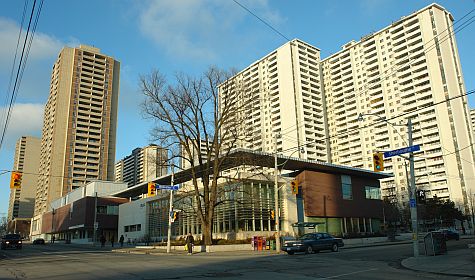It's late and I had been reading over St Jamestown. There are so many facts and statistics about this little pocket of community.
Most of them I got from MoveIn.to (a movement to encourage young Christians to move and live in poorer neighborhoods to bring Jesus to the community).
- 64% of residents are immigrants − 74% arrived in Canada between 1991 and 2006
My family came to Canada in 1988. When I look that most arrive between 1991 to 2006, most of the people there are quite new immigrants. When a family first come to Canada from foriegn country, they will settle down temporarily, get a job, get income, then move on to a permanent (probably better) home. When we see that 74% moved in and stayed in St Jamestown, we see that most are probably too poor to move out and struggling to make a living.
- 55% of residents over age 15 have a post-secondary certificate, diploma or degree − 59% received their degree outside Canada
Coming from Mississauga, a suburb, I can say all of my friends have post-secondary certificate. My social circle and myself is that I am quite well off. When we see 55% of those over 15 lack a post secondary education, basically most just had a highschool education. This hampers any job with a decent income especially in today when everyone has a secondary degree (question..if 55% do not have post secondary, is it my stereotype to assume everyone?!?). Most will work for low income and labor-intensive jobs. This is hard on the family from health wise (less money to spend on grocery to get healthy food) to their future (secondary education is not cheap, retirement is slim when living paycheck to paycheck).
- In 2006, 51% of residents were considered to have low, before-tax incomes as compared with 18% in the rest of Toronto, making this a high-poverty neighbourhood
This is perhaps the saddest statistics. St Jamestown is not only poorer. It is poorer of the poor. A comparison of 18% to 51% is huge. It is a strong contrast. It is not just 1 out of 5 families are poor but 1 out of 2 families are struggling to provide adequate necessities. This is bad in many manners. First, no one wants to live in a poor neighborhood. Those who can make it out will leave once they have more money. Second, local economic drainage, low income areas = less money to spend in local business. Those who own the little shops, like the convenience store or the supermarket or the hair dresser or the clothing store probably live in the same neighborhood as well. So when no one spends, they suffer as well. This is one of the reason why the poorer gets poorer. Third, I think it is harder...by nature for people to spend money in a poorer neighborhood. Take my own experience, when I go to Toronto, I don't go to the poorer neighborhoods. I go to the place to shop, to have fun etc. I stayed away from the poorer neighborhoods because there is nothing to do there. This further makes it harder for the poor to make a living.
...better head to bed..but lots of prayer tonight.....

No comments:
Post a Comment